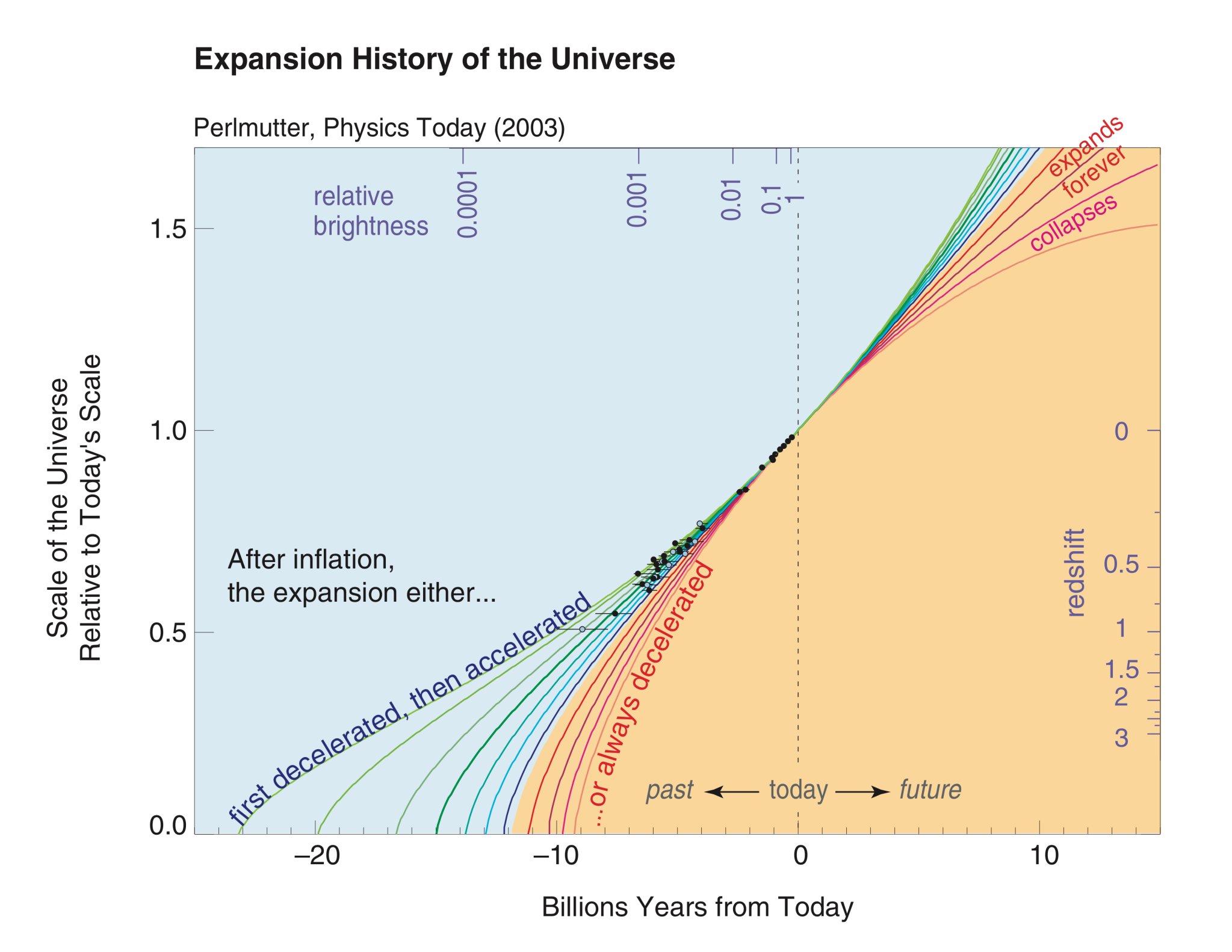
Most galaxies occupy groups or clusters with from 10 to hundreds of members. Each cluster is held together by the gravity from each galaxy. The more mass, the higher the velocities of the members, and this fact can be used to test for the presence of unseen matter.

Up to 95% of the mass in clusters is not seen, or dark. Since the physics of the motions of galaxies is so basic, there is no escaping the conclusion that a majority of the matter in the Universe has not been identified, and that the matter around us is special. The question that remains is whether dark matter is baryonic (normal) or a new substance.
Rotation Curve of Galaxy:
How do we measure the amount of mass in the Universe? We measure gravity, indirectly by measuring motion and apply Newton's law of gravity.
The orbital period of the Sun around the Galaxy gives us a mean mass for the amount of material inside the Sun's orbit. But a detailed plot of the orbital speed of the Galaxy as a function of radius reveals the distribution of mass within the Galaxy. The simplest type of rotation is wheel rotation shown below.

Rotation following Kepler's 3rd law is shown above as planet-like or differential rotation. Notice that the orbital speeds falls off as you go to greater radii within the Galaxy. This is called a Keplerian rotation curve.
To determine the rotation curve of the Galaxy, stars are not used due to interstellar extinction. Instead, 21-cm maps of neutral hydrogen are used. When this is done, one finds that the rotation curve of the Galaxy stays flat out to large distances, instead of falling off as in the figure above. This means that the mass of the Galaxy increases with increasing distance from the center.
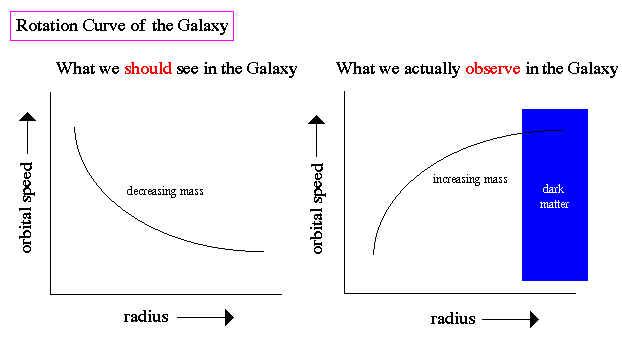
The surprising thing is there is very little visible matter beyond the Sun's orbital distance from the center of the Galaxy. So the rotation curve of the Galaxy indicates a great deal of mass, but there is no light out there. In other words, the halo of our Galaxy is filled with a mysterious dark matter of unknown composition and type.
Dark Matter:
From comparing the mass estimates to the observed amount of light from galaxies, and from the abundance of light elements, that there is a problem with the fraction of the mass of the Universe that is in normal matter or baryons. The fraction of light elements indicates that the density of the Universe in baryons is only 2 to 4% what we measure as the observed density. The rest of the mass appears to be `missing', meaning unobserved or dark.
Exactly how much of the Universe is in the form of dark matter is a mystery and difficult to determine, obviously because its not visible. It has to be inferred by its gravitational effects on the luminous matter in the Universe (stars and gas) and is usually expressed as the mass-to-luminosity ratio (M/L). A high M/L indicates lots of dark matter, a low M/L indicates that most of the matter is in the form of baryonic matter, stars and stellar remnants plus gas.
A important point to the study of dark matter is how it is distributed. If it is distributed like the luminous matter in the Universe, that most of it is in galaxies. However, studies of M/L for a range of scales shows that dark matter becomes more dominate on larger scales.

Most importantly, on very large scales of 100 Mpc's (Mpc = megaparsec, one million parsecs and kpc = 1000 parsecs) the amount of dark matter inferred is near the value needed to close the Universe. Thus, it is for two reasons that the dark matter problem is important, one to determine what is the nature of dark matter, is it a new form of undiscovered matter?, the second is the determine if the amount of dark matter is sufficient to close the Universe.
Baryonic Dark Matter:
It is not too surprising to find that at least some of the matter in the Universe is dark since it requires energy to observe an object, and most of space is cold and low in energy. Can dark matter be some form of normal matter that is cold and does not radiate any energy? For example, dead stars?
Once a star has used up its hydrogen fuel, it usually ends its life as a white dwarf star, slowly cooling to become a black dwarf. However, the timescale to cool to a black dwarf is thousands of times longer than the age of the Universe. High mass stars will explode and their cores will form neutron stars or black holes. However, this is rare and we would need 90% of all stars to go supernova to explain all of the dark matter.

Another avenue of thought is to consider low mass objects. Stars that are very low in mass fail to produce their own light by thermonuclear fusion. Thus, many, many brown dwarf stars could make up the dark matter population. Or, even smaller, numerous Jupiter-sized planets, or even plain rocks, would be completely dark outside the illumination of a star. The problem here is that to make-up the mass of all the dark matter requires huge numbers of brown dwarfs, and even more Jupiter's or rocks. We do not find many of these objects nearby, so to presume they exist in the dark matter halos is unsupported.
Non-Baryonic Dark Matter:
An alternative idea is to consider forms of dark matter not composed of quarks or leptons, rather made from some exotic material. If the neutrino has mass, then it would make a good dark matter candidate since it interacts weakly with matter and, therefore, is very hard to detect. However, neutrinos formed in the early Universe would also have mass, and that mass would have a predictable effect on the cluster of galaxies, which is not seen.
Another suggestion is that some new particle exists similar to the neutrino, but more massive and, therefore, more rare. This Weakly Interacting Massive Particle (WIMP) would escape detection in our modern particle accelerators, but no other evidence of its existence has been found.
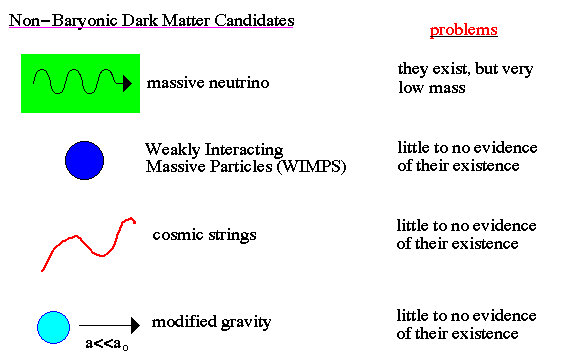
The more bizarre proposed solutions to the dark matter problem require the use of little understood relics or defects from the early Universe. One school of thought believes that topological defects may have appears during the phase transition at the end of the GUT era. These defects would have had a string-like form and, thus, are called cosmic strings. Cosmic strings would contain the trapped remnants of the earlier dense phase of the Universe. Being high density, they would also be high in mass but are only detectable by their gravitational radiation.
Lastly, the dark matter problem may be an illusion. Rather than missing matter, gravity may operate differently on scales the size of galaxies. This would cause us to overestimate the amount of mass, when it is the weaker gravity to blame. This is no evidence of modified gravity in our laboratory experiments to date.
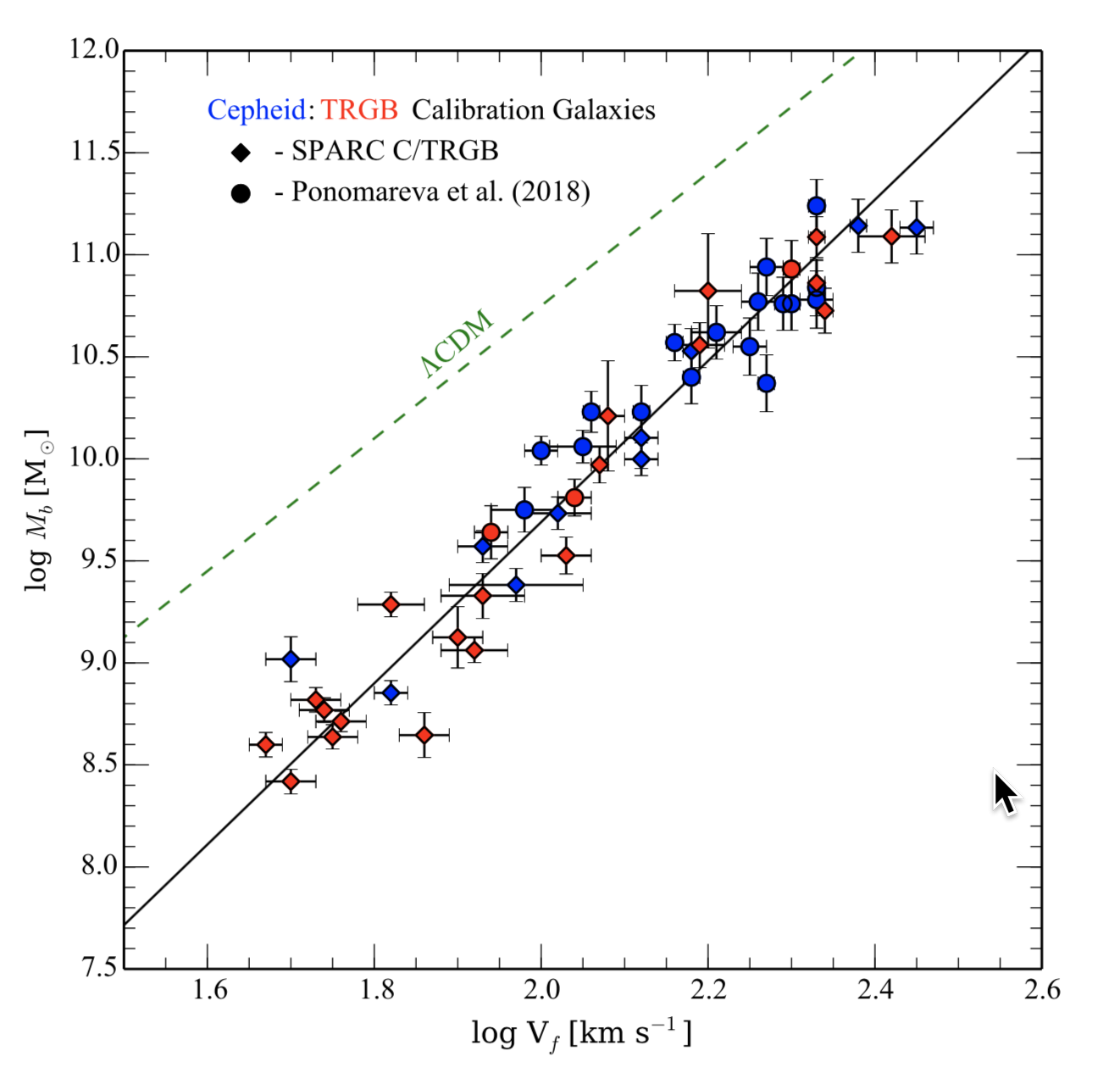
The baryon Tully-Fisher relation shown above is the clearest connection between baryons and dark matter in the sense that baryons trace the dark matter, which is impossible in any current dark matter framework.
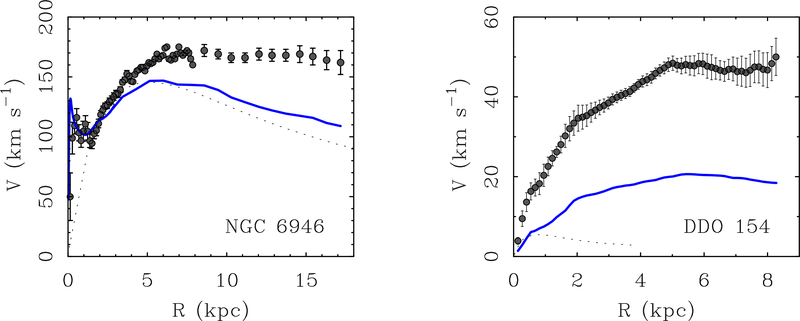
Renzo's rule outlined in the above figure, where ever there is a bump in the baryons (blue line) there is a corresponding bump in kinematics (black dots). Again, impossible in any dark matter scenario.

The McGaugh Dark Matter tree, outlineing all the possible dark matter scenarios.

The scoreboard for MOND, a priori tests have the greatest significance in science
Dark Energy:
The current observations and estimates of dark matter is that 20% of dark matter is probably in the form of massive neutrinos, even though that mass is uncertain. The another 5% to 10% is in the form of stellar remnants and low mass, brown dwarfs. The rest of dark matter is called CDM (cold dark matter) of unknown origin, but probably cold and heavy. The combination of all these mixtures only makes 20 to 30% the amount mass necessary to close the Universe. Thus, the Universe appears to be open, i.e. ΩM is 0.3.
With the convergence of our measurement of Hubble's constant and ΩM, the end appeared in site for the determination of the geometry and age of our Universe. However, all was throw into turmoil recently with the discovery of dark energy. Dark energy is implied by the fact that the Universe appears to be accelerating, rather than decelerating, as measured by distant supernovae.

Two proposed forms of dark energy are the cosmological constant, representing a constant energy density filling space homogeneously, and scalar fields such as quintessence. Quintessence would represent itself as a fifth fundamental force, but one that is dynamic and changes with time. Contributions from scalar fields that are constant in space are usually also included in the cosmological constant. The cosmological constant can be formulated to be equivalent to the zero-point radiation of space i.e. the vacuum energy. Scalar fields that change in space can be difficult to distinguish from a cosmological constant because the change may be extremely slow.

This new observation implies that something else is missing from our understanding of the dynamics of the Universe, in math terms this means that something is missing from Friedmann's equation. That missing something is the cosmological constant, Λ.

Einstein first introduced Λ to produce a static Universe in his original equations. However, until the supernova data, there was no data to support its existence in other than a mathematical way.
To understand the meaning of the cosmological constant remember that general relativity states that its not just matter that warps spacetime. Energy equals mass, so energy can also produce gravity. One type of energy comes from pressure. Pressure can be positive, like a compressed spring, and positive pressure makes attractive gravity like mass. However, you can also have negative pressure, meaning the pressure pulls inward rather than pushing outward. Negative pressure can produce negative or repulsive gravity.
The substance that we call dark energy has this property of having negative pressure and, therefore, acts as repulsive gravity. Dark energy may simply be an effect of spacetime, that all pieces of spacetime have an intrinsic energy. The effect on the Universe as a whole is an acceleration of the expansion, minor in early times when gravity from matter dominates, increasingly important as the Universe ages and grows larger until acceleration dominates.
Dark energy produces a contribution of 0.7 to Ω, called ΩΛ , so that matter plus dark energy equals an Ω of 1, a flat Universe.
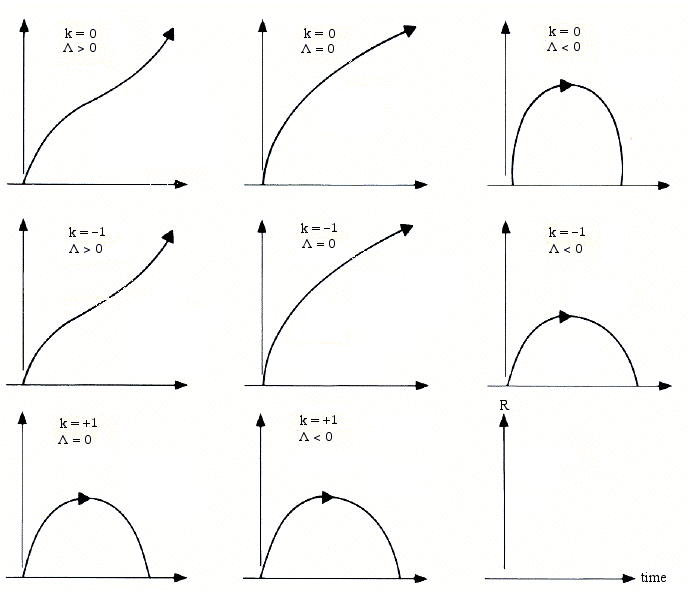
With a cosmological constant, the possible types of Universes is very open. Almost any kind of massive or light, open or closed curvature, open or closed history is possible. Also, with high Λ's, the Universe could race away.
Fortunately, observations, such as the SN data and measurements of Ω allow us to constraint the possible models for the Universe. In terms of Ω for k (curvature), M (mass) and Λ (where the critical values are Ω=1), the new cosmology is given by the following diagram.
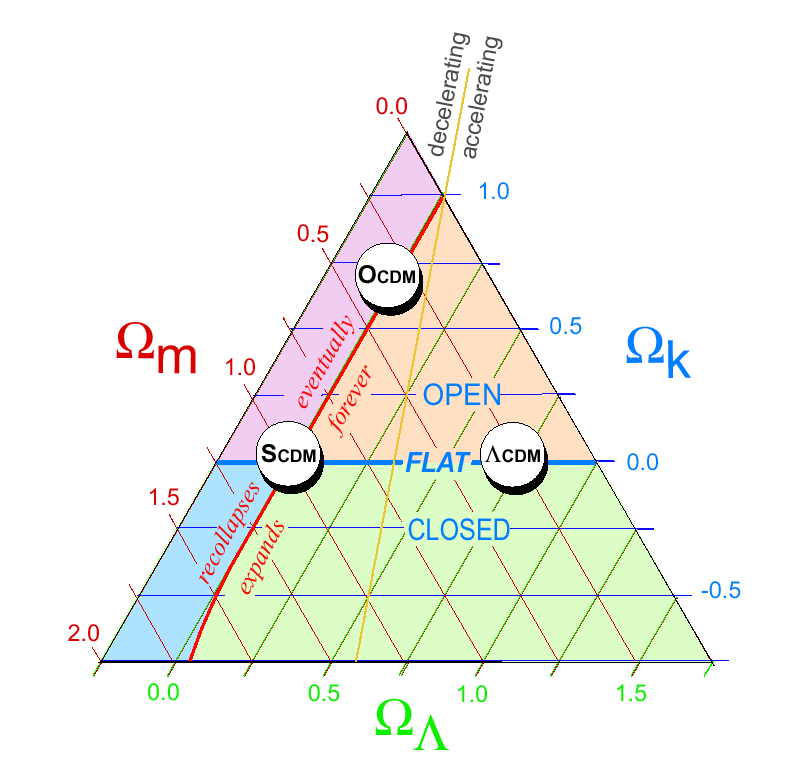
SN data gives ΩΛ=0.7 and ΩM=0.3. This results in Ωk=0, or a flat curvature. This is sometimes referred to as the Benchmark Model which gives an age of the Universe of 12.5 billion years.

